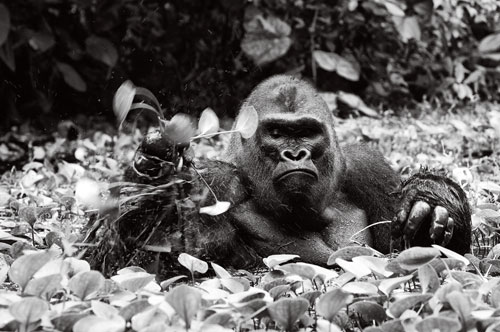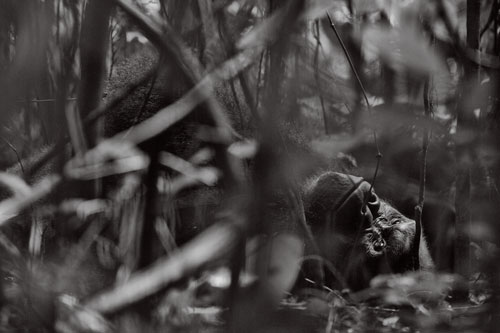
- A chimpanzee in the Goualougo Triangle, part of Ndoki National Park in the Republic of Congo, holds a puncturing tool. Chimpanzees use tool kits to forage for termites—a hard stick to break into the mound and a soft herb, made into a brush by running it through their teeth, to pull the termites from the nest.
Ian Nichols kicked through mud puddles teeming with parasites that wormed into exposed patches of wet skin and settled in his blood. Flying insects blitzed his face and, in surrender to episodic fits of self-defense, he’d crush one between thumb and forefinger, releasing insect pheromones that lured a fresh storm of attackers to the sweat between his shoulder blades. Rain clattered through the arch of trees, and he would shiver in a thin poncho, far beneath ancient limbs that crackled and split but stretched into a canopy woefully empty of primates. Days of thick heat saw him waiting—a speck in a swampy, remote pocket of primary rainforest that sweeps across Africa’s great middle— hoping for a glimpse of any great apes, but they would not come.
Only barely habituated to humans, the chimpanzees of the Goualougo Triangle near the northwestern border of the Republic of Congo would scatter as the humans thudded close. Hours, weeks of trekking yielded a few live sightings but provided little chance to sit nearby and gain the confidence that comes from watching and learning minute shifts in their habits and expressions. “I was getting good shots,” Nichols says now, “but, because of the long periods of not shooting, it was easy to fall into a bad headspace.”
There was also, it seemed, little of significance to show from the camera traps, sensor-triggered devices that he had carefully positioned in various locations—beside a termite mound to catch chimps feeding with the aid of tools or among oozing windfalls from a fruiting tree. He set up six platforms that he had, with help from a seasoned team of British technicians, installed among the tree branches to face full frontal into the chimps’ world. These tree platforms he’d envisioned as a way to avoid shots aimed upward from the forest floor toward a simian dot barely visible against the white blaze of the sky. He’d climbed up with a rope to the tree canopy and sat from sunup to sundown. “I wanted the animals to get used to them. But a lot of them were near bees,” he says, forcing him to abandon two of the platforms. “You’re taking a gamble,” Nichols says. The gamble paid off; one shot of a chimp in the forest canopy ran in National Geographic magazine.
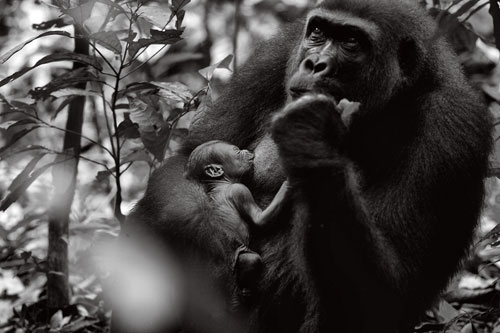
- Beatrice, a female lowland gorilla from the Mondika study site, suckles her infant Gentile. Lowland gorillas are listed as endangered on the IUCN Red List due to habitat loss, poaching, disease, and because they have a high infant mortality rate.
From the western Atlantic shores of central Africa, the rainforests of the Congo Basin swell across Gabon, Cameroon, Equatorial Guinea, the Central African Republic, the Republic of Congo (or Congo-Brazzaville) and into its vast, violent neighbor across the Congo river, the Democratic Republic of Congo (or DRC), ending in the volcanic plateau of the Great Rift Valley toward the eastern Horn. Into the jungle’s midst, among an estimated sixty million inhabitants, fritter rebels, armed bandits, refugees, loggers, mineral prospectors, and poachers. It was in the eastern fringe of the jungle, where DRC meets Rwanda and Uganda in undulating hills, that mountain gorillas achieved global notoriety— first as well-loved subjects of study for the martyred zoologist, Diane Fossey, then as casualties of war, butchered or sickened to a few hundred in the crossfire of back-to-back conflicts since 1994 that have ensured the region’s ongoing claim to most lethal humanitarian crisis since World War II.
Habitat loss, weak law enforcement, and, particularly, the eternal scourge of the bushmeat trade threaten the wildlife throughout the Congo Basin. In Congo-Brazzaville, Nichols says, planes returned heavy with cargo of bushmeat, and an outbreak of Ebola at the nearby Odzala National Park had recently wiped out most of the lowland gorillas in the park. But in the remote nature reserves to the northwest, near the Central African Republic, anti-poaching patrols were strong as a matter of border security. The chief wars there were among chimps.
Nichols spent the better part of 2007 and 2008 in the Nouabale-Ndoki National Park, documenting the chimps’ tool-making habits at Goualougo and at the Mondika site, sitting daily with lowland gorillas—though no closer than seven meters to avoid spreading human illnesses to the apes. Until then, Nichols says, the shorterfurred cousins of the eastern mountain gorillas had escaped extensive photography. He took so many photos they almost form a flipbook.
With a grant from the National Geographic Society after graduating from UVA and a solid cool for African travel acquired from time accompanying his photographer father, the young Nichols, now 29, landed in Brazzaville, flew aboard an old Russian charter to the center of the country, boated six to eight hours upriver, offloaded at the Bomassa research camp, drove up a logging road to a remote dock, then canoed about two hours and walked six more to the satellite research camp. “I think the logistics aspect would drive most people completely crazy,” he says. “I’d take a flight and then the boat wouldn’t be there, or it was raining or there was no gas. But I knew to expect that.”
With indefatigable constancy, he woke before dawn then trekked out at 5 a.m. and worked until 5 p.m. Returning just shy of the guillotine of an equatorial sunset, he would plunge into the pinklit river near the camp to wash, then, exhausted, fall asleep in the sudden dark to the din of the jungle and the hum of stories traded over campfires between the scientists and the fine-boned, nomadic people of the forest, the BiAka pygmies.
By day, guided always by one or two pygmy trackers, he would patrol his traps, clearing the lenses of a veil of steam, ants, or the daily refuse from the mass of decaying undergrowth. Once, he found a camera askew and smashed, as if mauled by some great beast. An elephant, perhaps? It was the kind of discovery that kindled tales of indifferent tramplings and tusk-skewerings told to scare the city folk of Brazzaville.
It turned out later, when the sensor-triggered camera delivered the evidence, that the vandal was a leopard with a habit of stealing around the termite mound. It had been prowling for its dinner, hoping to catch a chimpanzee preoccupied with prodding and sweeping for termites. But Nichols bettered the leopard, his camera trap catching the kinetic sinews of the reclusive feline’s form and a gaze limpid with the menace of unchallenged power. He snapped an elephant too, shaking a vine—probably, Nichols says, to intimidate the impudent clicking camera.
And so, on he pursued. Until one day, like the pygmy had predicted, he peered ahead into the dim, green tangle and something, somewhere, felt new, amiss—different. “Look for what seems out of the ordinary,” Makody had said. Perhaps he’d see it in a vine that hung by a thread, a mound of dirt careening at a strange angle, or leaves trampled and scattered apart, as if something heavy and fleshy had recently thrashed through. Nichols knew he had begun to understand— was it weeks in? months?—when the tracker up ahead veered off in a direction that felt plain wrong. In a flash, the photographer turned to the pygmy behind. Makody beamed back a broad, toothy grin. The brief exchange carried all the nuance of a language they didn’t otherwise share. For the man of the forest and his white charge, it was a proud moment.
“If you’ve been in the forest a while, you start to see things better,” Nichols says. “You look in a tree, trying to see a little monkey. For the first months, it’s very difficult to see; there’s all this green and distraction. But then you start to be able to focus in and see that dot.”
In the gorilla community, Nichols quickly learned to understand their furious chestthumping as all show and bluster. His photos capture their expressions, their personalities, the fine-tuned structure of their society. Here is the silverback of the group, the adult male, gathering leaves in a swamp in the early morning a few moments before he noticed the humans. There is a female—snapped with the beatitude of a veritable Madonna with Child—allowing the human to look at her suckling her infant. “As soon as you paid attention to a baby, most of the females would turn away and hide it.” But this female, Nichols says, had shown a special trust in allowing him to see her infant—and its impact, as an image, is immediately recognizable.
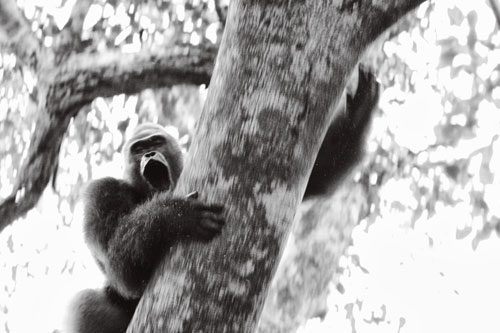
- A silverback gorilla barks and slides down a tree at the sight of researchers. This male was protecting his group, drawing attention to himself as the others slipped away.
Great wildlife photographs, Nichols says, are like that. They require no explanation. “That photo of the chimp,” for example, the lone male caught in a moment of poise, “there’s just a calmness to it.” With one hand clutching his termite-poking stick and the other on his foot, the tear in one ear—a badge of battle from transgressing into the territory of another chimp community or defending his own—he has the quiet dignity of a Depression-era laborer in a Walker Evans portrait.
In the end, Nichols’ photos also tell of something richer. Like his scientist colleagues, he seeks to widen the frontiers of our understanding about animals whose worlds we risk destroying through mere contact. (For fear of that, researchers and trackers were careful to pack out everything they brought, even bagging their own excrement.) Sustained observation provided Nichols with unexpected insights. “I hadn’t really thought how hard it was to be a silverback,” Nichols laughs. “Each has a harem. Females would be all over the place eating. The silverback would try to move the group. He’d call out to them and they wouldn’t come. He had this sour expression.”
Of the chimps, Nichols notes, that people have dismissed their tool-making as crude and one-dimensional. But he saw them employ a hard stick to break a hole into the termite nest, then poke a soft herb, formed into a brush by perforating it with their teeth, into the hole to pull out the termites. They plan this, Nichols says. “They have a method in their minds.”
If he can, Nichols will return to Africa—next time in the restive east to explore that primate urge for power, resources, and land. In Uganda, in a place of excess fruit trees where all survival needs are sated, chimps have expanded their territory over 20 percent—maybe the only place on earth where primate habitat is expanding. And woe betide trespassers. Begins there, with no small irony reflected in the human misery nearby, the genetic origins of our proclivity for war.
Delphine Schrank’s essay “Tin Fever,” about the Bisie mine in the Democratic Republic of Congo, appeared in the Fall 2010 issue.
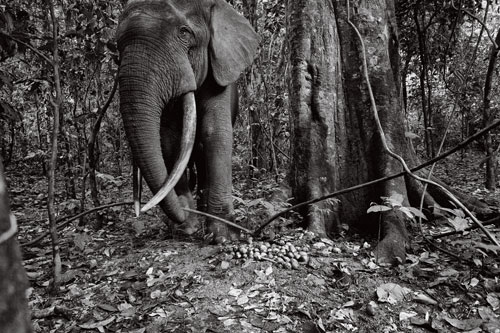
- A forest elephant triggers a camera trap at a fruiting tree. Researchers use fruit falls to study possible Ebola transmission routes. One theory is that fruit bats carry the virus and pass it to fruit that is then consumed by other animals.
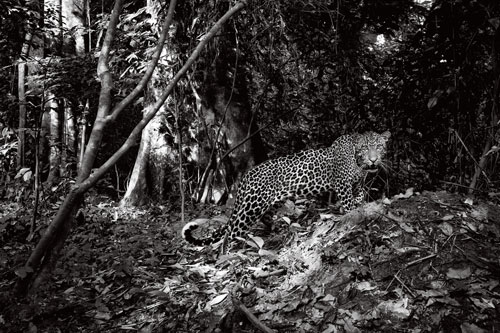
- A leopard visits a termite mound often used by an older female chimpanzee. Leopards are incredibly intelligent and careful hunters and prey on the most vulnerable of the chimpanzees. Termite fishing is a great way for chimpanzees to obtain protein, but it also leaves them vulnerable to predators on the forest floor.







